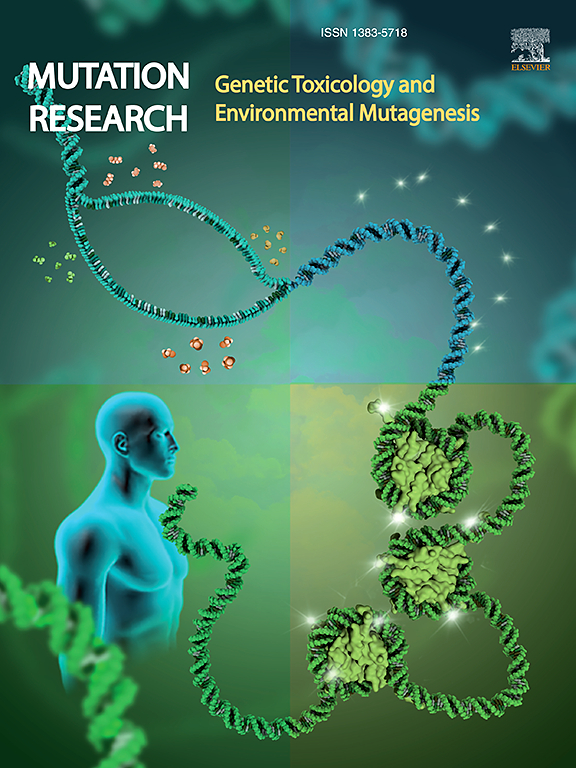A comparative analysis of select P450 enzymes in uninduced and PB/BNF-induced hamster and rat liver S9
IF 2.5
4区 医学
Q3 BIOTECHNOLOGY & APPLIED MICROBIOLOGY
Mutation research. Genetic toxicology and environmental mutagenesis
Pub Date : 2025-02-01
DOI:10.1016/j.mrgentox.2025.503855
引用次数: 0
Abstract
The assessment of potentially carcinogenic N-nitrosamine impurities in drugs has become crucial for the pharmaceutical industry to ensure public safety. The in vitro Ames test, which uses rat or hamster liver S9 for metabolic activation, is an important component of regulatory test batteries for assessing mutagenicity and has been the traditional method for assessing the potential mutagenicity of chemicals, including N-nitrosamines. This test, however, has shown inconsistencies with some N-nitrosamines, raising concerns about the liver S9's ability to activate N-nitrosamines to their proximate mutagens. Assays from Vivid® CYP450 Screening Kits and the 7-benzyloxyquinoline assay were used to measure substrate activities of P450 enzymes involved in N-nitrosamine metabolism in rat and hamster liver S9. Both uninduced and induced rat and hamster liver S9 preparations were used. The results provide a comparative assessment of the metabolic competency of the rodent S9s to metabolize N-nitrosamines to their mutagenic forms. Hamster S9 consistently showed increased CYP activity compared to rat S9 under the same conditions. Induced rat S9 also displayed relatively high conversion levels, with the greatest increase in 7-benzyloxyquinoline conversion (CYP3A-like activity) over uninduced (15.7-fold). The highest increase observed with induced hamster S9 was for CYP2A6-like activity which was induced over 7.8-fold and was ∼60-fold higher in induced hamster S9 compared to induced rat S9. These results demonstrate that both rat and hamster S9 contain relevant P450 enzyme activities for N-nitrosamine bioactivation, but hamster S9 is recommended for nitrosamine in vitro tests due to its overall higher P450 activity levels.
P450酶在未诱导和PB/ bnf诱导的仓鼠和大鼠肝脏中的比较分析
药物中潜在致癌性n -亚硝胺杂质的评估已成为制药行业确保公共安全的关键。体外Ames试验利用大鼠或仓鼠肝脏S9进行代谢激活,是评估突变性的调控试验电池的重要组成部分,是评估包括n -亚硝胺在内的化学物质潜在突变性的传统方法。然而,该试验显示与某些n -亚硝胺不一致,这引起了人们对肝脏S9激活n -亚硝胺对其近似诱变剂的能力的担忧。采用Vivid®CYP450筛选试剂盒和7-苯氧喹啉法测定大鼠和仓鼠肝脏S9中参与n -亚硝胺代谢的P450酶的底物活性。采用未诱导和诱导的大鼠和仓鼠肝脏S9制剂。这些结果提供了啮齿动物S9s代谢n -亚硝胺到其致突变形式的代谢能力的比较评估。在相同条件下,仓鼠S9与大鼠S9相比,CYP活性持续增加。诱导大鼠S9也显示出相对较高的转化水平,7-苯氧喹啉转化(cyp3a样活性)比未诱导的增加最多(15.7倍)。与诱导的大鼠S9相比,诱导的仓鼠S9中cyp2a6样活性的增加幅度最大,达到7.8倍以上,而诱导的仓鼠S9中cyp2a6样活性的增加幅度为60倍。这些结果表明,大鼠和仓鼠S9都含有与n -亚硝胺生物活性相关的P450酶活性,但仓鼠S9因其整体P450活性水平较高而被推荐用于亚硝胺体外试验。
本文章由计算机程序翻译,如有差异,请以英文原文为准。
求助全文
约1分钟内获得全文
求助全文
来源期刊
CiteScore
3.80
自引率
5.30%
发文量
84
审稿时长
105 days
期刊介绍:
Mutation Research - Genetic Toxicology and Environmental Mutagenesis (MRGTEM) publishes papers advancing knowledge in the field of genetic toxicology. Papers are welcomed in the following areas:
New developments in genotoxicity testing of chemical agents (e.g. improvements in methodology of assay systems and interpretation of results).
Alternatives to and refinement of the use of animals in genotoxicity testing.
Nano-genotoxicology, the study of genotoxicity hazards and risks related to novel man-made nanomaterials.
Studies of epigenetic changes in relation to genotoxic effects.
The use of structure-activity relationships in predicting genotoxic effects.
The isolation and chemical characterization of novel environmental mutagens.
The measurement of genotoxic effects in human populations, when accompanied by quantitative measurements of environmental or occupational exposures.
The application of novel technologies for assessing the hazard and risks associated with genotoxic substances (e.g. OMICS or other high-throughput approaches to genotoxicity testing).
MRGTEM is now accepting submissions for a new section of the journal: Current Topics in Genotoxicity Testing, that will be dedicated to the discussion of current issues relating to design, interpretation and strategic use of genotoxicity tests. This section is envisaged to include discussions relating to the development of new international testing guidelines, but also to wider topics in the field. The evaluation of contrasting or opposing viewpoints is welcomed as long as the presentation is in accordance with the journal''s aims, scope, and policies.

 求助内容:
求助内容: 应助结果提醒方式:
应助结果提醒方式:


